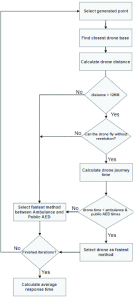A Data-Driven Simulator for the Strategic Positioning of Aerial Ambulance Drones Reaching Out-of-Hospital Cardiac Arrests: A Genetic Algorithmic Approach
- PMID: 32399316
- PMCID: PMC7210790
- DOI: 10.1109/JTEHM.2020.2987008
A Data-Driven Simulator for the Strategic Positioning of Aerial Ambulance Drones Reaching Out-of-Hospital Cardiac Arrests: A Genetic Algorithmic Approach
Abstract
Objective: The Internet of Things provide solutions for many societal challenges including the use of unmanned aerial vehicles to assist in emergency situations that are out of immediate reach for traditional emergency services. Out of hospital cardiac arrest (OHCA) can result in death with less than 50% of victims receiving the necessary emergency care on time. The aim of this study is to link real world heterogenous datasets to build a system to determine the difference in emergency response times when having aerial ambulance drones available compared to response times when depending solely on traditional ambulance services and lay rescuers who would use nearby publicly accessible defibrillators to treat OHCA victims.
Method: The system uses the geolocations of public accessible defibrillators and ambulance services along with the times when people are likely to have a cardiac arrest to calculate response times. For comparison, a Genetic Algorithm has been developed to determine the strategic number and positions of drone bases to optimize OHCA emergency response times.
Conclusion: Implementation of a nationwide aerial drone network may see significant improvements in overall emergency response times for OHCA incidents. However, the expense of implementation must be considered.
Keywords: AED; OHCA; UAV; ambulance drone.
Figures











References
-
- Statista Research Department. (Apr. 23, 2020). Statista, Internet of Things (IoT) Spending Worldwide 2023. Accessed: Apr. 28, 2020. [Online]. Available: https://www.statista.com/statistics/976313/global-iot-market-size/
-
- Sanseverino E. R.et al., “Smart cities: Case studies,” in Smart Cities Atlas. Springer, 2017, pp. 47–140.
-
- Lennartsson J., “Strategic placement of ambulance drones for delivering defibrillators to out of hospital cardiac arrest victims,” KTH Roy. Inst. Technol, Stockholm, Sweden, 2015.

